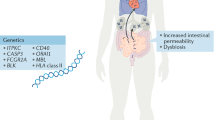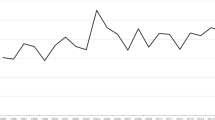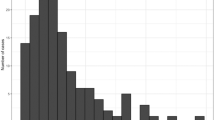Key Points
-
Epidemiologic data strongly suggest an infectious aetiology for Kawasaki disease, which is the leading cause of acquired heart disease among children in developed countries
-
Necrotizing arteritis, subacute chronic vasculitis, and luminal myofibroblastic proliferation are three linked processes underlying the arteriopathy associated with Kawasaki disease
-
Genetic susceptibility is indicated by the strikingly high rate of Kawasaki disease in children of Asian ethnicity and by its increased incidence in first-degree relatives of affected patients
-
Timely diagnosis and treatment of Kawasaki disease with intravenous immunoglobulin (IVIg) and aspirin substantially decreases the risk of developing coronary artery abnormalities
-
Adjunctive therapy with corticosteroids is of value in Japanese patients at particularly high risk of coronary complications, but identification of such high-risk patients is difficult in ethnically diverse populations
-
Management of patients who do not respond to standard therapy is challenging; options include pulsed steroids, additional IVIg, and infliximab or other immunomodulatory agents
Abstract
This Review summarizes recent advances in understanding of the pathologic processes and pathophysiologic mechanisms leading to coronary arteritis in Kawasaki disease, and describes current approaches to its treatment. Kawasaki disease is the most common cause of acquired heart disease among children in developed countries, in whom the resulting coronary artery abnormalities can cause myocardial ischaemia, infarction and even death. Epidemiologic data strongly suggest an infectious aetiology, although the causative agent has yet to be identified. Genetic factors also increase susceptibility to Kawasaki disease, as indicated by its strikingly high incidence rate in children of Asian ethnicity and by an increased incidence in first-degree family members. The treatment of Kawasaki disease is based on timely administration of intravenous immunoglobulin and aspirin. However, the management of patients who do not respond to this standard therapy remains challenging; although several options are available, comparative data on which to base treatment decisions are scarce. The added value of adjunctive therapy with corticosteroids in patients at particularly high risk of coronary complications has been demonstrated in Japanese populations, but identification of high-risk patients has proven to be difficult in ethnically diverse populations.
This is a preview of subscription content, access via your institution
Access options
Subscribe to this journal
Receive 12 print issues and online access
$209.00 per year
only $17.42 per issue
Buy this article
- Purchase on Springer Link
- Instant access to full article PDF
Prices may be subject to local taxes which are calculated during checkout

Similar content being viewed by others
References
Kawasaki, T. Acute febrile mucocutaneous syndrome with lymphoid involvement with specific desquamation of the fingers and toes in children [Japanese]. Arerugi 16, 178–222 (1967).
Amano, S., Hazama, F. & Hamashima, Y. Pathology of Kawasaki disease: I. Pathology and morphogenesis of the vascular changes. Jpn Circ. J. 43, 633–643 (1979).
Yanagisawa, M., Kobayashi, N. & Matsuya, S. Myocardial infarction due to coronary thromboarteritis, following acute febrile mucocutaneous lymph node syndrome (MLNS) in an infant. Pediatrics 54, 277–280 (1974).
Kato, H., Koike, S., Yamamoto, M., Ito, Y. & Yano, E. Coronary aneurysms in infants and young children with acute febrile mucocutaneous lymph node syndrome. J. Pediatr. 86, 892–898 (1975).
Amano, S., Hazama, F. & Hamashima, Y. Pathology of Kawasaki disease: II. Distribution and incidence of the vascular lesions. Jpn Circ. J. 43, 741–748 (1979).
Taubert, K. A., Rowley, A. H. & Shulman, S. T. Seven-year national survey of Kawasaki disease and acute rheumatic fever. Pediatr. Infect. Dis. J. 13, 704–708 (1994).
Yanagawa, H. et al. A nationwide incidence survey of Kawasaki disease in 1985–1986 in Japan. J. Infect. Dis. 158, 1296–1301 (1988).
Rodó, X. et al. Tropospheric winds from northeastern China carry the etiologic agent of Kawasaki disease from its source to Japan. Proc. Natl Acad. Sci. USA 111, 7952–7957 (2014).
Yim, D., Curtis, N., Cheung, M. & Burgner, D. Update on Kawasaki disease: epidemiology, aetiology and pathogenesis. J. Pediatr. Child Health 49, 704–708 (2013).
Onouchi, Y. Genetics of Kawasaki disease: what we know and don't know. Circ. J. 76, 1581–1586 (2012).
Brogan, P. A. Shah, V., Clarke, L. A., Dillon, M. J., & Klein, N. T cell activation profiles in Kawasaki syndrome. Clin. Exp. Immunol. 151, 267–274 (2008).
Rowley, A. H., Eckerley, C. A., Jack, H. M., Shulman, S. T. & Baker, S. C. IgA plasma cells in vascular tissue of patients with Kawasaki syndrome. J. Immunol. 159, 5946–5955 (1997).
Rowley, A. H. et al. Cloning the arterial IgA antibody response during acute Kawasaki disease. J. Immunol. 175, 8386–8391 (2005).
Rowley, A. H. et al. IgA plasma cell infiltration of proximal respiratory tract, pancreas, kidney, and coronary artery in acute Kawasaki disease. J. Infect. Dis. 182, 1183–1191 (2000).
Rowley, A. H., Shulman, S. T., Spike, B. T., Mask, C. A. & Baker, S. C. Oligoclonal IgA response in the vascular wall in acute Kawasaki disease. J. Immunol. 166, 1334–1343 (2001).
Rowley, A. H. et al. Cytoplasmic inclusion bodies are detected by synthetic antibody in ciliated bronchial epithelium during acute Kawasaki disease. J. Infect. Dis. 192, 1757–1766 (2005).
Rowley, A. H. et al. RNA-containing cytoplasmic inclusion bodies in ciliated bronchial epithelium months to years after acute Kawasaki disease. PLoS ONE 3, e1582 (2008).
Rowley, A. H. et al. Detection of antigen in bronchial epithelium and macrophages in acute Kawasaki disease by use of synthetic antibody. J. Infect. Dis. 190, 856–865 (2004).
Rowley, A. H. et al. Ultrastructural, immunofluorescence, and RNA evidence support the hypothesis of a “new” virus associated with Kawasaki disease. J. Infect. Dis. 203, 1021–1030 (2011).
Nielsen, H. B. et al. Identification and assembly of genomes and genetic elements in complex metagenomic samples without using reference genomes. Nat. Biotechnol. 32, 822–828 (2014).
Nakamura, Y. et al. Epidemiologic features of Kawasaki disease in Japan: results of the 2009–2010 nationwide survey. J. Epidemiol. 3, 216–221 (2012).
Holman, R. C. et al. Hospitalizations for Kawasaki syndrome among children in the United States, 1997–2007 Pediatr. Infect. Dis. J. 29, 483–488 (2010).
Holman, R. C. et al. Racial/ethnic differences in the incidence of Kawasaki syndrome among children in Hawaii. Hawaii Med. J. 69, 194–197 (2010).
Newburger, J. W. et al. Diagnosis, treatment, and long-term management of Kawasaki disease: a statement for health professionals from the Committee on Rheumatic Fever, Endocarditis and Kawasaki Disease, Council on Cardiovascular Disease in the Young, American Heart Association. Circulation 110, 2747–2771 (2004).
JCS Joint Working Group. Guidelines for diagnosis and management of cardiovascular sequelae in Kawasaki disease (JCS 2013). Digest version. Circ. J. 78, 2521–2562 (2014).
Fujiwara, H. & Hamashima, Y. Pathology of the heart in Kawasaki disease. Pediatrics 61, 100–107 (1978).
Sasaguri, Y. & Kato, H. Regression of aneurysms in Kawasaki disease: a pathological study. J. Pediatr. 100, 225–231 (1982).
Orenstein, J. M. et al. Three linked vasculopathic processes characterize Kawasaki disease: a light and transmission electron microscopic study. PLoS ONE 7, e38998 (2012).
Kuijpers, T. W. et al. Longstanding obliterative panarteritis in Kawasaki disease: lack of cyclosporin A effect. Pediatrics 112, 986–992 (2003).
Burke, A. P. et al. Fatal Kawasaki disease with coronary arteritis and no coronary aneurysms. Pediatrics 101 (Pt 1), 108–112 (1998).
Satoda, M., Tatsukawa, H. & Katoh, S. Images in cardiovascular medicine. Sudden death due to rupture of coronary aneurysm in a 26-year-old man. Circulation 97, 705–706 (1998).
Heaton, P. & Wilson, N. Fatal Kawasaki disease caused by early occlusive coronary artery disease. Arch. Dis. Child. 87, 145–146 (2002).
Ozawa, J. et al. Two cases of new coronary aneurysms that developed in the late period after Kawasaki disease. Pediatr. Cardiol. 34, 1992–1995 (2013).
Toyono, M. et al. Expanding coronary aneurysm in the late phase of Kawasaki disease. Pediatr. Int. 54, 155–158 (2012).
Tsuda, E., Kamiya, T., Ono, Y., Kimura, K. & Echigo, S. Dilated coronary arterial lesions in the late period after Kawasaki disease. Heart 91, 177–182 (2005).
Kobayashi, T., Sone, K., Shinohara, M., Kosuda, T. & Kobayashi, T. Images in cardiovascular medicine. Giant coronary aneurysm of Kawasaki disease developing during postacute phase. Circulation 98, 92–93 (1998).
Kawai, H. et al. Two cases with past Kawasaki disease developing acute myocardial infarction in their thirties, despite being regarded as at low risk for coronary events. Heart Vessels http://dx.doi.org/10.1007/s00380-014-0541-4.
Tsuda, E., Hanatani, A., Kurosaki, K., Naito, H. & Echigo, S. Two young adults who had acute coronary syndrome after regression of coronary aneurysms caused by Kawasaki disease in infancy. Pediatr. Cardiol. 27, 372–375 (2006).
Onouchi, Z. et al. Coronary artery aneurysms develop in weanling rabbits with serum sickness but not in mature rabbits. An experimental model for Kawasaki disease in humans. Angiology 46, 679–687 (1995).
Rosenkranz, M. E. et al. TLR2 and MyD88 contribute to Lactobacillus casei extract-induced focal coronary arteritis in a mouse model of Kawasaki disease. Circulation 112, 2966–2973 (2005).
Lau, A. C., Duong, T. T., Ito, S., Wilson, G. J. & Yeung, R. S. M. Inhibition of matrix metalloproteinase-9 activity improves coronary outcome in an animal model of Kawasaki disease. Clin. Exp. Immunol. 157, 300–309 (2009).
Takahashi, K. et al. Histopathologic features of murine systemic vasculitis caused by Candida albicans extract—an animal model of Kawasaki disease. Inflamm. Res. 53, 72–77 (2004).
Orenstein, J. M. & Rowley, A. H. An evaluation of the validity of the animal models of Kawasaki disease vasculopathy. Ultrastruct. Pathol. 38, 245–247 (2014).
Reindel, R. et al. Integrins α4 and αM, collagen1A1, and matrix metalloproteinase 7 are upregulated in acute Kawasaki disease vasculopathy. Pediatr. Res. 73, 332–336 (2013).
Reindel, R. et al. CD84 is markedly up-regulated in Kawasaki disease arteriopathy. Clin. Exp. Immunol. 177, 203–211 (2014).
Reindel, R. et al. Periostin is upregulated in coronary arteriopathy in Kawasaki disease and is a potential diagnostic biomarker. Pediatr. Infect. Dis. J. 33, 659–661 (2014).
Fujita, Y. et al. Kawasaki disease in families. Pediatrics 84, 666–669 (1989).
Uehara, R., Yashiro, M., Nakamura, Y. & Yanagawa, H. Kawasaki disease in parents and children. Acta Paediatr. 92, 694–697 (2003).
Park, Y. W. et al. Epidemiological features of Kawasaki disease in Korea, 2006–2008. Pediatr. Int. 53, 36–39 (2011).
Huang, W. C. et al. Epidemiologic features of Kawasaki disease in Taiwan, 2003–2006. Pediatrics 123, e401–e405 (2009).
Onouchi, Y. et al. ITPKC functional polymorphism associated with Kawasaki disease susceptibility and formation of coronary artery aneurysms. Nat. Genet. 40, 35–42 (2008).
Kuo, H. C. et al. Single nucleotide polymorphism rs7251246 in ITPKC is associated with susceptibility and coronary artery lesions in Kawasaki disease. PLoS ONE 12, e91118 (2014).
Onouchi, Y. et al. Common variants in CASP3 confer susceptibility to Kawasaki disease. Hum. Mol. Genet. 19, 2898–2906 (2010).
Kuo, H. C. et al. CASP3 gene single nucleotide polymorphism (rs72689236) and Kawasaki disease in Taiwanese children. J. Hum. Genet. 56, 161–165 (2011).
Onouchi, Y. et al. A genome-wide association study identifies three new risk loci for Kawasaki disease. Nat. Genet. 44, 517–521 (2012).
Lee, Y. C. et al. Two new susceptibility loci for Kawasaki disease identified through genome-wide association analysis. Nat. Genet. 44, 522–525 (2012).
Weng, K. P. et al. IL-1B polymorphism in association with initial intravenous immunoglobulin treatment failure in Taiwanese children with Kawasaki disease. Circ. J. 74, 544–551 (2010).
Onouchi, Y. et al. ITPKC and CASP3 polymorphisms and risks for IVIG unresponsiveness and coronary artery lesion formation in Kawasaki disease. Pharmacogenomics J. 13, 52–59 (2013).
Newburger, J. W. et al. The treatment of Kawasaki syndrome with intravenous gamma globulin. N. Engl. J. Med. 315, 341–347 (1986).
Newburger, J. W. et al. A single intravenous infusion of gamma globulin as compared with four infusions in the treatment of acute Kawasaki syndrome. N. Engl. J. Med. 324, 1633–1639 (1991).
Furusho, K. et al. High-dose intravenous gammaglobulin for Kawasaki disease. Lancet 2, 1055–1058 (1984).
Terai, M. & Shulman, S. T. Prevalence of coronary artery abnormalities in Kawasaki disease is highly dependent on gamma globulin dose but independent of salicylate dose. J. Pediatr. 131, 888–893 (1997).
Newburger, J. W. et al. Randomized trial of pulsed corticosteroid therapy for primary treatment of Kawasaki disease. N. Engl. J. Med. 356, 663–675 (2007).
Ogata, S. et al. Corticosteroid pulse combination therapy for refractory Kawasaki disease: a randomized trial. Pediatrics 129, e17–e23 (2012).
Inoue, Y. et al. A multicenter prospective randomized trial of corticosteroids in primary therapy for Kawasaki disease: clinical course and coronary artery outcome. J. Pediatr. 149, 336–341 (2006).
Kobayashi, T. et al. Efficacy of immunoglobulin plus prednisolone for prevention of coronary artery abnormalities in severe Kawasaki disease (RAISE study): a randomised, open-label, blinded-endpoints trial. Lancet 379, 1613–1620 (2012).
Sleeper, L. A. et al. Evaluation of Kawasaki disease risk-scoring systems for intravenous immunoglobulin resistance. J. Pediatr. 158, 831.e3–835.e3 (2011).
Tremoulet, A. H. et al. Infliximab for intensification of primary therapy for Kawasaki disease: a phase 3 randomised, double-blind, placebo-controlled trial. Lancet 383, 1731–1738 (2014).
Horosaki, T. et al. Long-term efficacy of plasma exchange treatment for refractory Kawasaki disease. Pediatr. Int. 54, 99–103 (2012).
Lee, T. J., Kim, K. H., Chun, J.-K. & Kim, D. S. Low-dose methotrexate therapy for intravenous immunoglobulin-resistant Kawasaki disease. Yonsei Med. J. 49, 714–718 (2008).
Tremoulet, A. H. et al. Calcineurin inhibitor treatment of intravenous immunoglobulin-resistant Kawasaki disease. J. Pediatr. 161, 506.e1–512.e1 (2012).
Shafferman, A., Birmingham, J. D. & Cron, R. Q. High dose anakinra for treatment of severe neonatal Kawasaki disease: a case report. Pediatr. Rheumatol. Online J. 12, 26 (2014).
Niedra, E., Chahal, N., Manlhiot, C., Yeung, R. S. & McCrindle, B. W. Atorvastatin safety in Kawasaki disease patients with coronary artery aneurysms. Pediatr. Cardiol. 35, 89–92 (2014).
Acknowledgements
The authors' research work is funded by NIH grants HL63771, HL109955 and AI106030 (to A.H.R.), the American Heart Association of Metropolitan Chicago (to A.H.R.), the Max Goldenberg Foundation (to A.H.R.), and the Centre for Kawasaki Disease at the Ann & Robert H. Lurie Children's Hospital of Chicago (to both authors).
Author information
Authors and Affiliations
Contributions
S.T.S. and A.H.R. contributed equally to researching data for the article, discussions of its content, writing the article, and review or editing of the manuscript before submission.
Corresponding author
Ethics declarations
Competing interests
The authors declare no competing financial interests.
Rights and permissions
About this article
Cite this article
Shulman, S., Rowley, A. Kawasaki disease: insights into pathogenesis and approaches to treatment. Nat Rev Rheumatol 11, 475–482 (2015). https://doi.org/10.1038/nrrheum.2015.54
Published:
Issue Date:
DOI: https://doi.org/10.1038/nrrheum.2015.54
This article is cited by
-
A pilot study of the differentiated landscape of peripheral blood mononuclear cells from children with incomplete versus complete Kawasaki disease
World Journal of Pediatrics (2024)
-
Prokineticin 2 as a potential biomarker for the diagnosis of Kawasaki disease
Clinical and Experimental Medicine (2023)
-
MCM8-mediated mitophagy protects vascular health in response to nitric oxide signaling in a mouse model of Kawasaki disease
Nature Cardiovascular Research (2023)
-
Comparison of IVIG resistance predictive models in Kawasaki disease
Pediatric Research (2022)
-
Atypical otolaryngologic manifestations of COVID-19: a review
The Egyptian Journal of Otolaryngology (2021)



